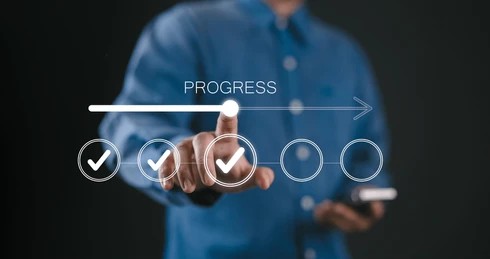From Busy to Effective: Building Systems that Actually Support You
You know the feeling.

You start the day with good intentions — a plan, a to-do list, maybe even a spark of motivation. But within hours, your schedule is derailed. The meetings pile up. The emails flood in. Unexpected requests land on your desk. You handle them all, barely pausing to breathe.
By the end of the day, you’ve been in constant motion but can’t point to anything meaningful you actually accomplished.
It’s frustrating. It’s exhausting. And it’s a reality for far too many professionals.
We’ve been conditioned to equate busyness with value. The more meetings, emails, and activity you juggle, the more essential you appear. But here’s the uncomfortable truth: being busy isn’t the same as being effective.
The Busyness Trap
Modern work culture rewards hustle, but it rarely rewards focus. Many high performers find themselves stuck in what I call “surface-level productivity.” They’re in motion all day but making little real progress.
The costs are significant:

- Mental fatigue and burnout
- Constant task-switching that erodes deep work
- Reactive decision-making under pressure
- Important priorities getting buried beneath the noise
Sound familiar? You’re not alone.
I’ve lived it myself — especially early in my career. I prided myself on being “always available,” thinking that responsiveness equaled value. But behind the scenes, my most critical projects suffered. I spent my energy reacting instead of leading.
It wasn’t until I learned to build systems around my time, energy, and focus that things changed.
Systems Create Space for Success
Think of personal systems like the infrastructure that supports a building. They hold things up, create stability, and free you to focus on what matters most.
When your systems are weak or nonexistent:

- Your schedule fills with distractions
- Your priorities get lost in the shuffle
- You spend your energy reacting to every new demand
But when your systems are strong:

- You protect time for high-impact work
- You reduce decision fatigue
- You build momentum through clarity and consistency
This isn’t about rigid routines or micromanaging your day. It’s about creating flexible, repeatable structures that support your goals and protect your capacity.
The best part? These systems are simple to implement, even if your schedule feels overwhelming right now.
Three Core Systems to Move from Busy to Effective
Let’s break down the three essential systems that help you move from reactive busyness to meaningful, focused effectiveness.
1. Workflow Filters: Say Yes to the Right Things
One of the biggest drivers of overwhelm is saying yes to everything — without evaluating whether it deserves your attention.
A workflow filter is a personal checkpoint you use to assess incoming work before committing. It helps you pause, reflect, and prioritize intelligently.
Here’s what that looks like in action:
Before saying yes to a new task, ask:
- Does this align with my top 2–3 priorities?
- Will this meaningfully move the needle for my role or organization?
- What am I sacrificing if I take this on?
If the answer is unclear or the impact is minimal, it may be time to push back or renegotiate expectations.
Real Example:
I once worked with an engineering team drowning in new project requests. Their default response was “We’ll figure it out”—but that mindset buried them. When we implemented workflow filters, the team learned to evaluate requests based on strategic alignment and resource capacity. Within weeks, their workload stabilized—and their output improved.
Your filter doesn’t have to be complicated. It just needs to slow the reflexive “yes” long enough for intentional decisions to happen.
2. Time Protection Strategies: Guard Your Focus
Without protected time, even the best priorities fall apart. Meetings, emails, and interruptions can swallow your day if you let them.
That’s where time protection systems come in. These are habits and boundaries that create space for deep, meaningful work — the kind of work that actually drives results.
Strategies to try:
- Block focused work time on your calendar and defend it like a meeting
- Batch similar tasks to reduce context switching
- Set clear expectations with your team about availability
- Use email autoresponders or status tools to minimize distractions
The truth:
Protecting your time isn’t selfish — it’s a leadership skill. It shows you respect your work, your team, and your energy.
Quick Tip:
Start small. Block 60–90 minutes each morning for your most critical work before the day gets hijacked by reactive tasks. You’ll be amazed how much momentum that creates.
3. Progress Tracking: Measure Output, Not Activity
Many professionals confuse busyness with progress. But checking off dozens of low-impact tasks won’t move you forward — only intentional progress does.
Progress tracking systems keep you aligned with your real goals and help you course-correct when distractions pull you off track.
One Simple System:
Use the “Top Three” method. At the start of each day, identify your three most important tasks, the ones that meaningfully advance your work or priorities.
Additional Tips:
- Reflect weekly on what progress you made
- Track time spent on deep work versus reactive tasks
- Adjust your systems based on what’s working
Story from the Field:
I once coached a project manager struggling with burnout. Their to-do list was pages long, but real progress was elusive. When we introduced daily top-three tracking and weekly reflections, their clarity skyrocketed. Within a few short weeks they were leading more effectively, with less stress.
Systems create accountability, accountability fuels effectiveness.
You Don’t Have to Figure This Out Alone
Let me be clear, building personal systems isn’t about perfection or rigid schedules. It’s about designing structures that support you, protect your time, and help you stay grounded when work gets chaotic.
And you don’t have to start from scratch.
That’s why I created this month’s free tool: the Personal Effectiveness Blueprint.
Inside, you’ll find:

- Simple frameworks for evaluating new work and saying yes to the right things
- Time protection habits that actually stick
- A progress tracking system to measure real results, not just activity
This blueprint is designed for busy professionals who want to lead more effectively without sacrificing their sanity.
Final Thoughts
You deserve better than surviving your workday on coffee, stress, and endless to-do lists.
When you shift from busy to effective, you reclaim your time, your focus, and your ability to make real progress without burning out in the process.
Want to take the first step?
Download your free Personal Effectiveness Blueprint and start building systems that support you so you can do your best work and still have energy left for life outside of work.
You don’t need to do more. You need to build better systems. This toolkit will help you start.